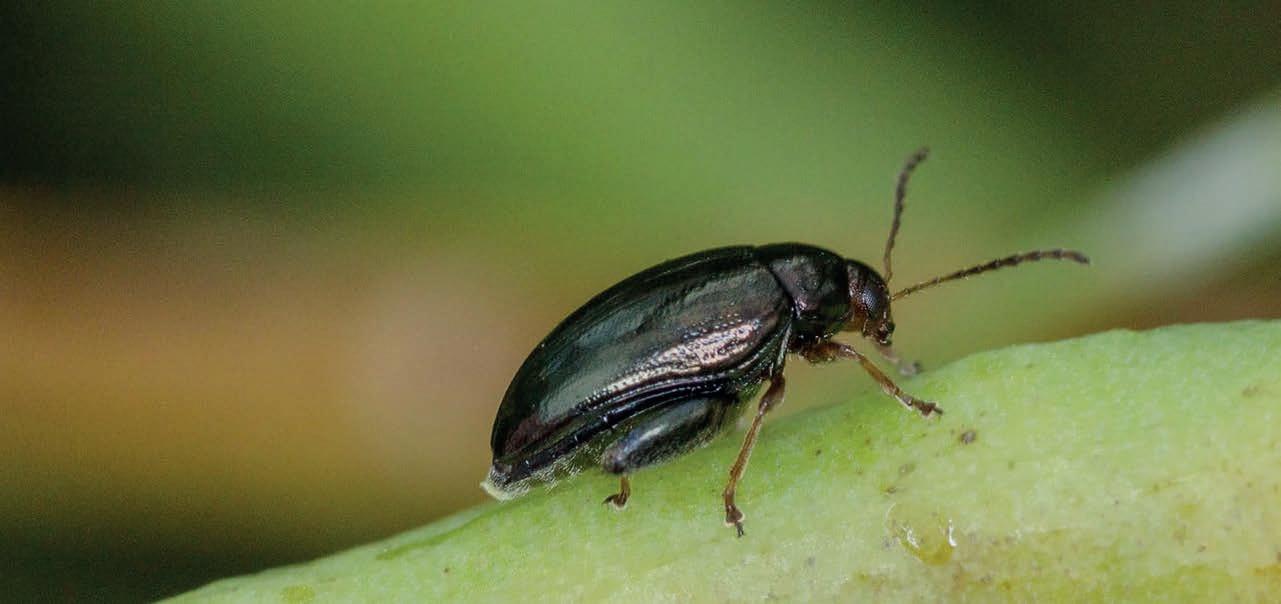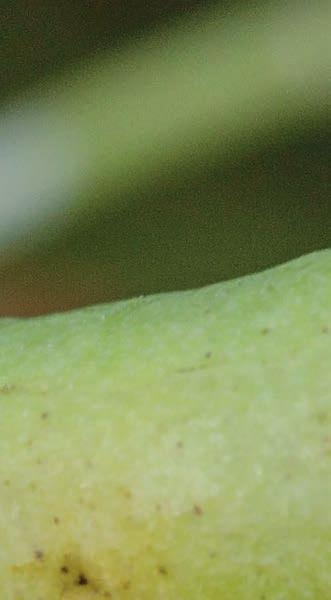
6 minute read
National study con rms less CSFB damage this season
CSFB damage down this season
Growers across the country sowing almost 12,000 hectares of winter oilseed rape last autumn report a redrilling rate of just 4% in a benchmarking study run by Bayer in conjunction with ADAS and NIAB in late March/early April.
This compares with 14% identified in an almost identical study undertaken at the same time last spring.
The survey reveals 90% of crops planted last autumn have survived through to spring and all are being taken through to harvest, against 67% and 61% respectively in 2020 (see graph).
Bayer study co-ordinator Lizzie Carr-Archer says: “This much improved position results from a combination of noticeably lower autumn cabbage stem flea beetle [CSFB] pressure as well as much better soil moisture conditions at drilling.
Intense
“Fewer than 20% of the 187 crops in our initial data were judged to have suffered an intense or substantial challenge from flea beetle last autumn against more than 50% in 2019.
“At the same time, only around 15% of this season’s crops had to deal with low or very low soil moisture conditions at establishment compared to nearly 40% last season. National winter OSR crop position
100
Proportion of crops (%)
80
60
40
20
0
SOURCE: National CSFB Management Studies 2020 and 2021 90% 90%
67%
61%
4% 14%
Redrilled Surviving to spring Being taken to harvest
2020/21 2019/20
“For the second year in a row, earlier August drillings gave higher levels of crop survival,” she adds. “The differences between these and later drillings was far less than in 2019, though.
“Unfortunately, as ever, some growers have clearly suffered more than most. However, it is
CSFB damage spells double trouble for OSR standing power
JCSFB damage weakens stem and restricts growth, rendering crops increasingly prone to lodging, ADAS work has confirmed.
ADAS entomologist Fran Pickering says: “It’s long been assumed that CSFB larvae and their activity affect stem strength, but we wanted to know, by how much? And taking it one step further, what impact does that have on lodging?”
The ADAS field trials took 50 plants at the end of flowering in May 2020 from two sites in East Anglia.
Strength
The team assessed the plants’ stem diameter, breaking strength and the internal damage caused by CSFB. By assessing the percentage area of stem damaged, the plants were sorted into five categories ranging from ‘minimal’ (plants with less than 5% damage), to ‘severe’ (plants with 76-100% of stem area damaged).
Ms Pickering says: “There was a clear trend showing thicker stems were stronger and while this is not news, the results also showed that higher damage was associated with the thinner stems. But why?”
The CSFB damage was predominantly mining and browning at the base of the stem and this type of damage restricts the take-up of nutrients and water, which in turn, restricts growth, adds Ms Pickering.

Fewer than 20% of the 187 crops in this season’s National Cabbage Stem Flea Beetle Management Study were judged to have suffered an intense or substantial challenge from flea beetle last autumn.

Results from the 2021 National Cabbage Stem Flea Beetle Management Study confirm a reduction in damage. CSFB damage down this season
More information
JFran Pickering and Tim Heyward were speaking in a BASF webinar titled ‘Helping spring decisions in OSR’, which is available in the BASF Real Results Virtual Farm webinar archive.
MORE For more from ONLINE the webinar, visit basfrealresultsfarm.com
really heartening to see how markedly the national position seems to have improved.
“And even where they are carrying significant larval burdens, many crops appear to be sufficiently well-established and vigorous enough to deal with them.”
Longer stubbles boost for CSFB management
JDrilling oilseed rape into a longer cereal stubble can significantly reduce damage from adult cabbage stem flea beetle regardless of sowing date or pest pressure, CSFB farm innovation group trials run by ADAS for Bayer this season have revealed.
Consistent reductions of 25-31% in shot-holing were recorded from direct sowing a fast-developing hybrid into stubbles of around 30cm against those of 15cm in the field-scale strip trials on three farms in Essex and Cambridgeshire (see graph).
Drilled from August 12 to September 6, all the trial fields had sufficient moisture levels during establishment, with the earliest sown incurring noticeably less flea beetle damage overall than the later-drilled sites.
Less CSFB grazing during
This work confirms that leaving longer stubbles can help crops tolerate adult grazing
RICHARD PHILLIPS
Adult CSFB damage (DK Excited sown into different stubble lengths)
70
SOURCE: ADAS/Bayer CSFB Management FIG Trials 2020
60
Shot-holing (%)
50
40
30
20
10
0
Field A – Essex (August 12 sown) Field B – Cambridgeshire (September 2 sown)
Field C – Essex (September 6 sown)
Short stubble Long stubble
early establishment meant the crops sown into longer stubbles went into winter with taller plants and generally higher plant populations than those sown into shorter stubbles.
Bayer OSR trials co-ordinator Richard Phillips says: “This work provides the first independent evidence of the anecdotal value of longer stubbles in systems which already have the CSFB management advantage of minimal soil surface disturbance. It confirms that, alongside other measures, leaving longer stubbles can help crops tolerate adult grazing.
“Together with earlier sowing, the national study of cabbage stem flea beetle management we ran with more than 220 growers across the country last season highlighted the importance of hybrid varieties, in general, and fast-developing as well as vigorously-establishing hybrids, in particular, in coping with the pest.
“Leaving longer stubbles on its own was not identified as a particularly successful management technique in this study. So, its success is likely to depend on careful integration with other cultural controls.”
Late-November assessments in the trials also revealed higher larval populations per plant in the longer stubble sowings on two of the three farms, Mr Philips adds.
“ADAS believes this warrants investigation as it may underline the importance of techniques such as growing hybrids that develop earlier in spring and winter defoliation considered to be valuable in reducing subsequent larval damage.”
“Plants taken from the second site revealed that for any given stem diameter, more damage makes stems weaker. The larval feeding not only restricts thickness of the stem but hollows stems, reducing their strength.
“Even low levels of CSFB damage significantly reduce stem strength. On average, stems with less than 25% damage were 29% weaker.”
Agronomic practices adopted to manage CSFB may also contribute to an increased lodging risk. Berkshire OSR grower Tim Hayward has changed how he grows OSR to combat the effects of CSFB.
He says: “Previously we were drilling after barley. We are a late farm so it would be the first week of September before OSR was in the ground. In 2019 and 2020 we had dry spells in September. That, together with the CSFB damage, meant we had some crop failures.
“Now, we’re direct drilling into long wheat stubbles and paying much more attention to the forecast.”
Being on thin chalk soils with restricted potential yields, Mr Hayward has not, historically, had a problem with lodging.
But moving to conventional seed sown at higher seed rates, combined with some larvae damage, means his crops are higher risk. However, with careful monitoring the risk is manageable, says Ms Pickering.









